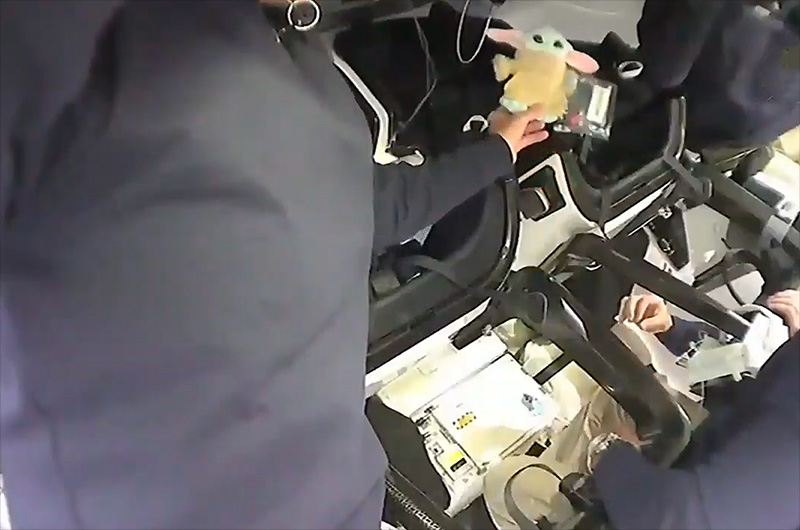 advertisements advertisements
|

|
'Baby Yoda' revealed as zero-g indicator on SpaceX Crew-1 mission
November 16, 2020 — The astronauts who lifted off on SpaceX's first operational crewed mission for NASA are proving "this is the way."
A few hours after launching to the International Space Station on Sunday (Nov. 15), the Crew-1 astronauts showed off their fifth crew member — a small plush doll of "The Child."
"And as you can see live, they have now revealed to us the zero-g indicator and it looks like a little baby Yoda!" said SpaceX engineer Jessica Anderson, describing the doll as she provided live mission commentary on NASA TV.
The toy, modeled after the character from the Disney+ Star Wars series "The Mandalorian," is part of a long tradition of astronauts flying small dolls to signal when they enter orbit. The toys, which are generally tethered to a wall or other anchor, begin to float about the cabin when the launch phase of the flight ends, indicating that the crew is in zero-g.
The custom began on Russian spaceflights, dating back to the first launch of a human into space in 1961. Soviet-era cosmonaut Yuri Gagarin carried a small doll with him on his Vostok 1 mission to watch it float. Since then, the zero-g indicators have varied from homemade dolls to off-the-shelf, commercial toys.
SpaceX adopted the practice with its first test flight of the Crew Dragon spacecraft, launching a plush doll of the planet Earth on its 2019 Demo-1 mission to the space station. The Celestial Buddies' Earth was then joined by a sequined apatosaur, "Tremor," which was chosen by the sons of Demo-2 crewmates Bob Behnken and Doug Hurley.
The "Little Earth" and dinosaur toys returned home with the Demo-2 astronauts earlier this year.
It was not yet clear why the Crew-1 astronauts — commander Michael Hopkins, pilot Victor Glover and mission specialists Shannon Walker and Soichi Noguchi — selected "The Child" as their zero-g indicator, though it might have something to do with their backup, NASA astronaut Kjell Lindgren.
A self-professed "big Star Wars fan," Lindgren convinced his crewmates on an earlier space station mission to dress up like Jedi for a NASA promotional poster and he picked out an R2-D2 toy to serve as the zero-g indicator for his 2015 launch on a Russian Soyuz spacecraft.
Hopkins, Glover, Walker and Noguchi were just beginning a 27-hour rendezvous with the space station when they displayed The Child on board the "Resilience," the name they gave their Crew Dragon spacecraft. "Baby Yoda says you guys can come back on board," said Glover, giving the flight controllers permission to turn on the cameras aboard the capsule.
The astronauts are expected to dock at the station on Monday (Nov. 16) at about 11 p.m. EST (0400 GMT on Nov. 17). After arriving, they will join other astronauts and cosmonauts to form the Expeditions 64 and 65 crews during their planned six-month stay.
In the meantime, The Child will continue to float around.
"As we get more views inside the cabin, we will have to keep an eye out and see if we might spot him again," NASA mission commentator Leah Cheshier said. |
|

A small plush toy of "The Child" or "Baby Yoda" from the Disney+ Star Wars series "The Mandalorian" is seen floating on board the SpaceX Crew Dragon "Resilience" as the zero-g indicator for the four Crew-1 astronauts on Sunday, Nov. 15, 2020. (NASA TV)

The Crew-1 astronauts' zero-g indicator, "The Child" ("Baby Yoda") from the Disney+ Star Wars series "The Mandalorian" floats into pilot Victor Glover's seat on the SpaceX Crew Dragon. (NASA TV) |

SpaceX Crew-1 pilot Victor Glover, a NASA astronaut, reaches for "The Child" ("Baby Yoda") aboard the Dragon capsule "Resilience" on Sunday, Nov. 15, 2020. The small plush doll of the Star Wars "The Mandalorian" character served as the crew's zero-g indicator. (NASA TV) |


|

© 1999-2025 collectSPACE. All rights reserved.
|
|

|

|
